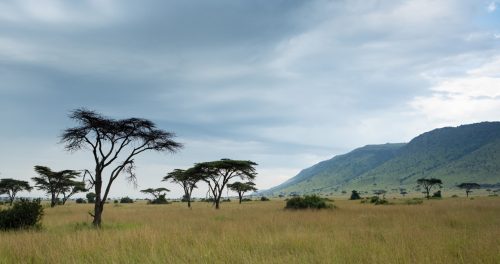The black panther has been associated with everything from political movements to Afrofuturistic expression. Its image has gripped audiences from around the world and become a symbol of power and mysticism. What exactly is a black panther? The stories and legends all originate from a small percentage of animals in the ‘Panthera’ genus, such as leopards and jaguars, who possess a very rare genetic trait that affects their melanin production. When a leopard is melanistic, it produces more melanin than normal to the point that the skin and fur become black. The spots or rosettes are still identifiable up close or in certain light, but the coat is a deep jet black.
It seems that this rare genetic trait could be advantageous to certain species. Generally, we've seen around the world that melanistic cats can adapt better to areas with more shade and bush. In Kenya, Laikipia is covered in bush and there are countless places to hide — the perfect place to be velvet black. This is where I saw Giza Mrembo which translates to 'beautiful darkness'.
After some failed attempts to locate Giza myself, I found a man named Steven from Samburu who was widely known as a black leopard expert. Together we drove through the hills of Laikipia at night searching from bush to bush. Every few moments Steven would stop, turn off the lights and the engine and close his eyes — forcing his attention on his sense of hearing alone. He was not only listening to sounds created by the leopard but also the animals around it — the alarm calls of dik-dik, impala, birds, and other animals.
Then we saw a velvet black tail sticking out of a bush. We slowly drove up and waited; within minutes we saw two deeply fierce eyes peering back at us. After establishing eye contact, I was overwhelmed with emotion. She has adapted so well to her environment and has been seen making multiple kills lately. Steven told me that only a couple of months ago, she was getting meals from her mother (who is not melanistic), but at just two years old, she has already started to rely solely on herself. If Giza decides to mate, the chances are high that at least one of her offspring will also be melanistic. We stayed with her as she weaved in and out of sight as the sun came up.
Several hours after sunset, we were able to find her again in full hunt mode. We watched her crouch and crawl from bush to bush. A shadow swiftly floating through the night. Twice she got very close to prey, once with a group of impala and once with a dik-dik. Both times she was unsuccessful, but as they say, the third time's the charm. Blending into the darkness she slowly approached another dik-dik. There was no chase; the prey had no idea she was there until it was too late. She literally plucked it out of the air and within minutes she was up in a tree. We left her to enjoy her reward.
Searching the bush at night looking for Giza was one of the most thrilling things I have ever experienced. Being in the presence of this magnificent creature was a true honour and I was blessed to have been able to do it. Thank you to Steven and Laikipia Wilderness for this wonderful experience. Giza has danced in the shadows of my dreams ever since.
Filed under: East Africa Travel
Subscribe for Weekly Stories
Comments (5):
1 November 2022
Superb article and photographs. Please do not publicize the leopard's location - these endangered creatures do not need increased human traffic or poachers threatening them.
11 September 2022
Magnificent! - Used to live in Kenya, amongst others in Maasai Mara, now in South Africa
3 September 2022
Where did you stay up in Laikipia? Do you have Steven's info?

Angama Safari Camp